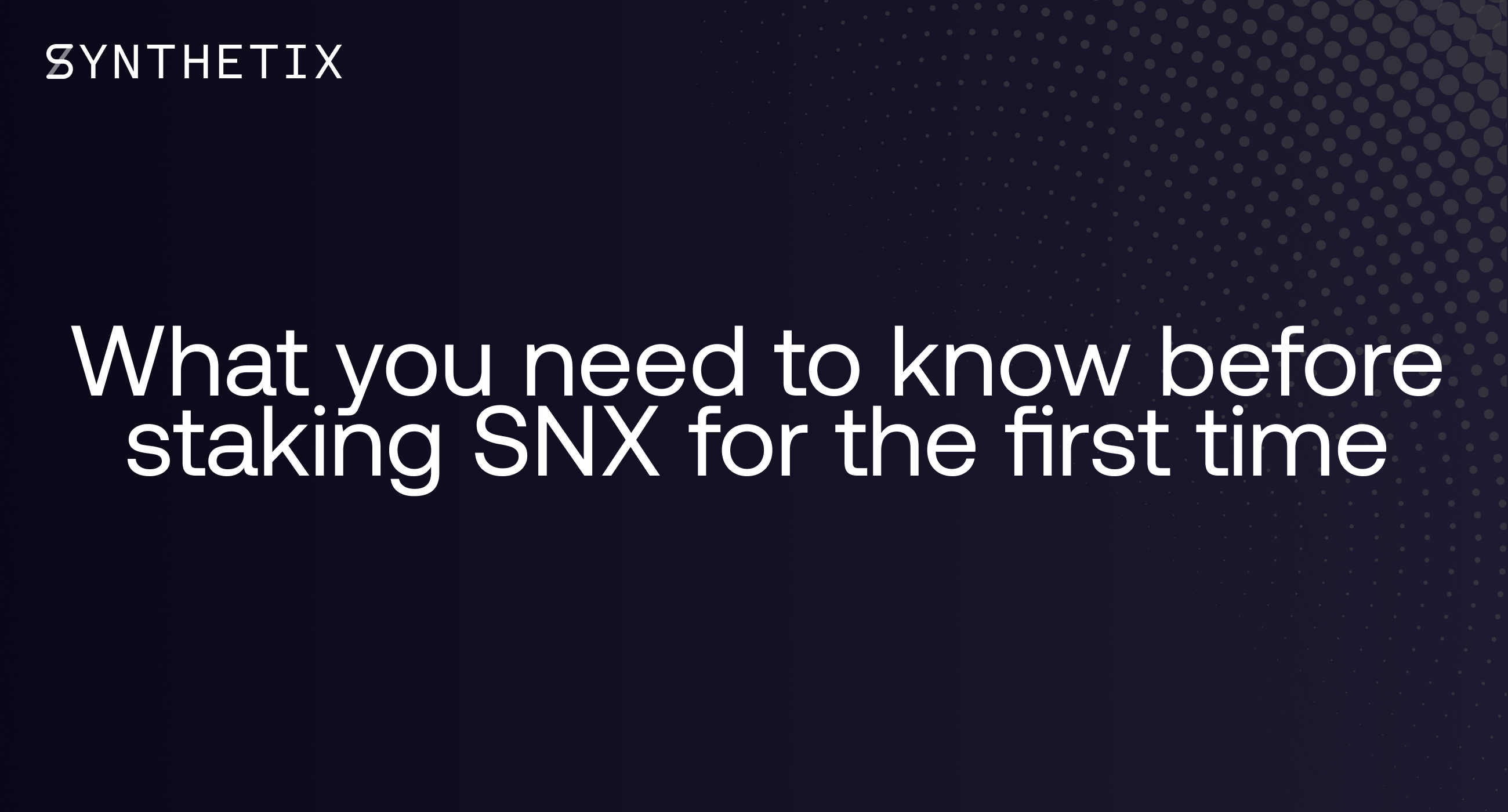What you need to know before staking SNX for the first time
Everything you should know before staking

Staking SNX allows anyone to earn rewards by contributing collateral to the Synthetix protocol. However, there are some important things you should know before you make the decision to contribute in this way.
Staking requires weekly action
- You receive two kinds of rewards for staking SNX: sUSD fees generated on Synthetix.Exchange, and SNX inflationary rewards. These rewards must be manually claimed in the one transaction each fee period (i.e. once a week) or they will be returned to the pool and redistributed to other stakers.
- The fee period closes at around 02:00 AM (UTC) every Wednesday. Each fee period, you can claim the rewards you earned for staking in the previous week.
- Before you can claim rewards, you need to ensure your Collateralisation Ratio is 500% or above. If your collateralisation ratio is below 500%, you can either add more SNX to your wallet or you can burn sUSD to help reduce its supply. (Please note that the C-Ratio can be adjusted via community governance)
- For more information on the different strategies you can use to manage your C-Ratio, visit this staking strategy page.
- Some stakers have complained about having to manage their C-Ratio and/or claim rewards so regularly, particularly when gas costs are high, but this is important because the supply of Synths needs to be managed closely. The total system C-Ratio must be kept near the target to ensure people maintain confidence that Synths are comfortably collateralised.
Gas costs are higher than most other protocols on Ethereum
- Before doing anything on Ethereum, you should really read up on how gas works, as it powers the entire blockchain and you’ll need this knowledge whenever you interact with Synthetix of anything else on Ethereum. Here are some resources: #1 and #2.
- On Ethereum, gas pays for computational power. This means that the more complex a protocol is, the more it will cost to execute transactions. This is how Ethereum is designed, and apart from making functions as computationally simple as possible, there is little the Synthetix core contributors can do to change this.
- The Synthetix protocol is far more complex than many other things you might do on Ethereum. For example, transferring Ether simply requires 21000 gas. Transferring SNX costs more gas than that, but can also vary as it needs to call `debtBalanceOfAndTotalDebt,` and if that wallet has any debt in the Synthetix system then it will need to do a large call to work out how many transferable SNX you have.
- If you’re particularly interested in keeping gas costs low, you can try claiming rewards at the start of a fee period with low gwei. This will mean that if the required gas costs drop during the week, your transaction will be executed. But this strategy is not perfect, as if the gas requirements never get as low as the gwei you set, you’ll need to cancel that transaction before the end of the fee period and try it again with a high enough gwei to clear.
Debt pool risk — why staking rewards don’t come for free
- When you stake, by minting sUSD you claim a portion of the debt pool. The debt pool represents the total value of all Synths in the system. To take an extreme example, if a majority of Synth holders are holding sBTC while BTC pumps, then the size of the debt pool will increase significantly. For more information, you can check out the “Stakers, debt, and pooled counterparties” section of the litepaper or this help page.
- If you take the sUSD you’ve minted and start trading on Synthetix.Exchange, be aware that you risk decreasing the value of your Synth holdings, which can cause you to end up with an insufficient quantity of sUSD to burn to cover your outstanding debt. To remedy this, you will need to add more sUSD to your wallet to burn to meet the target C-Ratio and pay the debt you owe to the system.
- Whenever you want to unstake your SNX, you’ll need to wipe out your debt completely by burning sUSD. If you are below the C-Ratio, you can either add more SNX to your wallet to reach the target ratio or you can burn sUSD to reduce the amount of SNX you owe the system.
SNX Staking Rewards cannot be transferred for one year
- SNX staking rewards (not sUSD fees) have an escrow period of one year before they can be vested. This just means that they are locked and can’t be transferred during that time.
- However, you can stake your escrowed SNX staking rewards, allowing you to mint more sUSD and increase your yield.
Support
Staking SNX is an exciting way to contribute to a promising DeFi protocol, but it is important to understand the mechanics of the system before getting started. If you need additional support or have any unanswered questions, join the Synthetix Discord where you can get useful information from community members and Synthetix core contributors.
Also, be sure to follow Synthetix on Twitter to stay on top of any updates!

